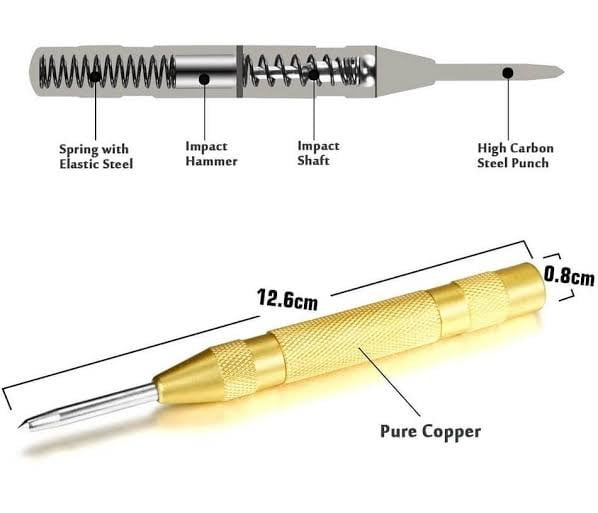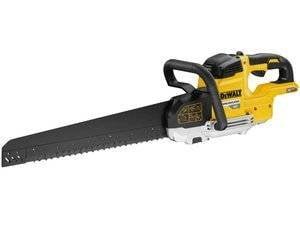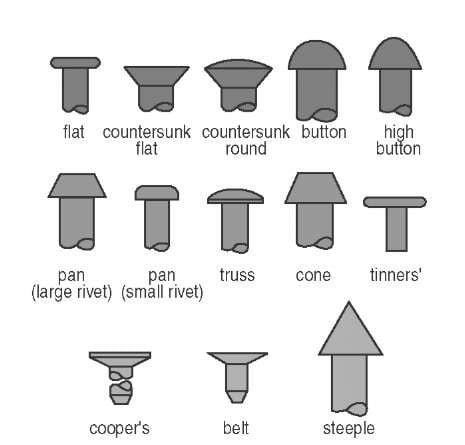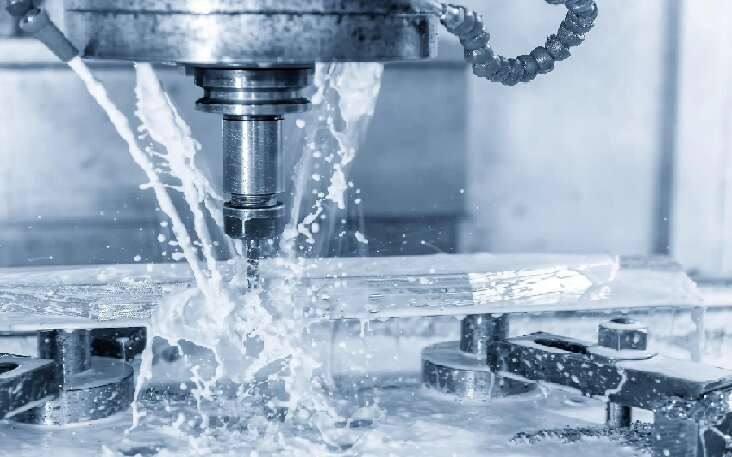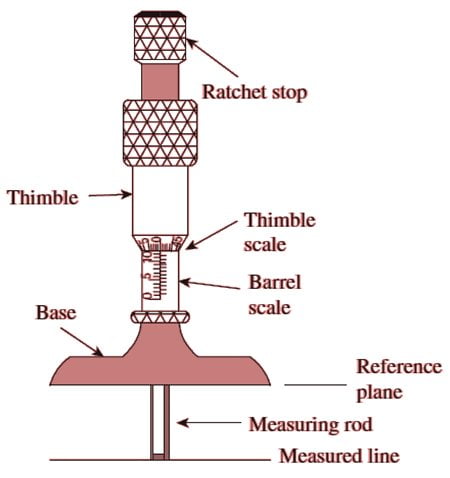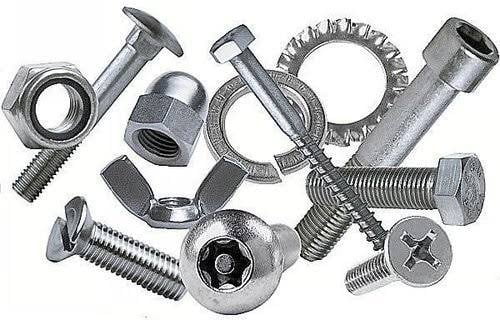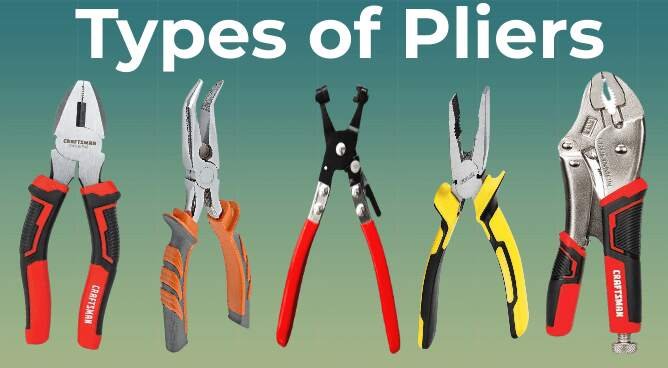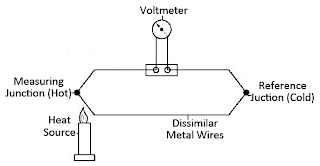In this article we will learn what is drop hammer forging process, how it is done, and what are the types of drop hammers.
Drop hammers are the simplest and oldest type of impact hammers or an industrial power hammer which is driven by steam that is used for tasks such as shaping forgings and driving piles.
The hammer is usually attached to a piston that slides within a fixed cylinder, but in some designs, the hammer is attached to a cylinder that slides along a fixed piston.

How Does a Drop Hammer Works ?
In power-assisted drop hammers, air or steam is used against a piston to supplement the force of gravity during the downward stroke. The energy used to deform the workpiece is obtained from the kinetic energy of the moving ram and die. Because hammers are energy-restricted machines, multiple blows (usually three) are required at each stage (i.e., for each die) during the forging process.
Types of Drop Hammer
Three types of drop hammers are used in making drop forgingsThey are board or gravity hammer, air-lift hammer, and power drop hammer or wha is usually called steam hammer. The working principle in each of the two types is almost similar to that of the forging hammers. The anvil block of forging hammer is built on a foundation separate from the frame, while the anvil of a drop forging hammer is attached to the frames to permit accurate alignment of the upper and lower dies.
1. Board Hammer
The principle of a board or gravity hammer is illustrated in fig. The ram is fastened to the lower end of a vertical hard-wood board ; the upper part of this board is placed between two counter revolving rolls. When both rolls are pressed against the board between them, they drive upward, lifting the ram. When the tools are released, the ram falls down producing a working stroke.
As long as the operator continues to hold down the treadle, the hammer will continue to strike, but when the treadle is depressed, the ram will return to and will remain in its top position. The board hammer is generally driven by electric motor and this requires no steam or high pressure air.
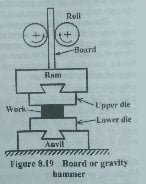
Ratings are given by the weight of the falling parts and 250 to 2700 kg ram weight with heights of 1 m for smaller sizes and 2 m range from for the larger one. The force of the blow can be varied by changing the distance of the fall, by unclamping and moving the dogs on the front rod.
The anvil, which must absorb the blow, is usually 20 times as heavy as the hammer. Wooden beams or special pads under the anvil help absorb the force. A board hammer, which works rapidly, gives over 300 blows a minute. Board hammers can do a wide variety of work and they are less expensive of all types to operate.
2. Air-lift Hammer
Air-lift hammers are modern drop hammer, which also derive their force from a free-falling ram. The hammer uses compressed air to lift the ram, then lets it fall by gravity similar to the board drop hammer. The ram is lifted by a steel rod connecting it to the piston. A separate air circuit operates a clamp which holds the ram in a raised position between strokes. A series of short and long-stroke blows can be obtained and the operator does not have to regulate the stroke heights. Program control is present to control the force and the number of blows at each die station. This automation can materially increase the production rate.
These hammers can make up to 50 to 75 strokes per minute depending on their size. Due to lower maintenance costs, and easier operation, air-lift hammers are replacing board hammers.
3. Power Drop Hammer
Power drop hammer, better known as air or steam hammer, has the same principle as that of a steam forging, but differs from a forging hammer in that the anvil of the former is an integral part of the frame to maintain perfect alignment between the forging die elements used. The steam or air drop hammer has the same essential parts as the board hammer except that a steam or air cylinder, piston, and rod are substituted for the board lifting mechanism. A power hammer using air or steam at a pressure of 7 kgf per cm² (690 kN/m²) will supply two to two and half times as much energy as the same rating of gravity drop hammer.
Steam or air hammers are the largest of the forging hammers and are made from 450 to 25,000 kg (mass) falling weight hammer with as anvil weighing 45,300 kg.
Capacity of Drop Hammer
The same factor as explained for forging hammers determines the energy and force delivered by a drop hammer. Direct calculations to determine what capacity is needed is quite complex. An empirical rule of thumb is that a gravity drop hammer’s rated size in kilograms should be equal to the product of the area of the final die-impression and the flash times 20 to 37, depending on the shape and type of material. A double-acting steam drop hammer may have a rating of 6 of that of a gravity drop hammer but be suited for the same job.
Advantages of Drop Hammer
Now that you understand what drop hammer forging is, consider some of the benefits this focused manufacturing process provides:
1. There is no waste.
2. Parts that are strong and have good mechanical properties
3. Method of rapid production
The drop hammer process also allows for the alignment of metal grains as well as potential stress locations, which improves overall strength. This process produces components that are generally stronger and last longer in high-stress environments, making it a valuable operational aspect of the manufacturing industry.
Disadvantages of Drop Forging
(1) Die preparation is a costly process.
(2) Die impression requires a good skill of work.
(3) Die maintenance is costly.
What is Drop Forging ?
Drop forging is the process of shaping metal and increasing its strength. In most forging, an upper die is forced against a heated workpiece positioned on a stationary lower die. If the upper die or hammer is dropped, the process is known as drop forging.
Drop forging :- Hammering hot metal into dies.
Is Drop Forging Strong?
Among all the metal materials, most popular material is drop forged steel. It is widely used because it is a very strong and stable metal that can withstand high temperature heating by drop forging machines, thus can be shaped.
What is Drop Forging Used For
Drop forging is used primarily to produce construction parts for machines such as planes or vehicles. Drop forging is also used to produce tools, e.g. wrenches, pliers and hammers.
Check Out Other Important Topics
Forging Operations – Types, Methods, Advantages, MCQs
Foundry Tools And Equipment – List, Names & Images
Types of Forging Defects – Causes & Remedies [with Images]
Moulding Sand – Properties, Types, Process, MCQs
Plant Layout – Types, Objectives, Principles, Advantages
| IC Engine | Important PDFs | Boilers | Synergy Maritime Exam | Naval Arch | MEO Class 4 |
| Interview Questions | Difference Between | Types of Pumps | Auxiliary Machines | Types of Valves | Home |

